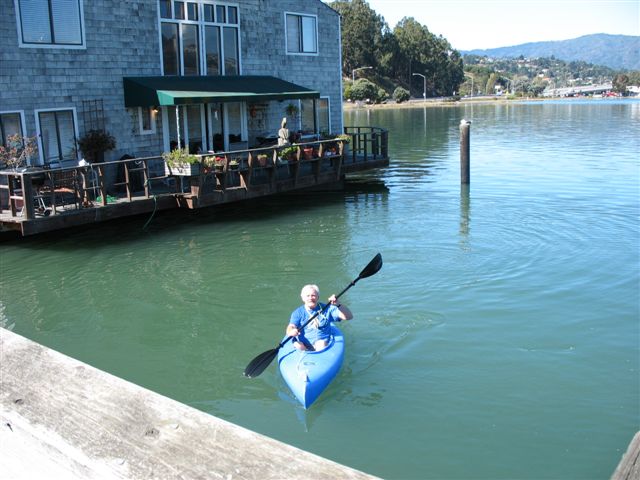by Larry Clinton
The following is updated from a 2009 Sausalito Historical Society column.
Visitors to Sausalito’s floating homes community frequently notice what appear to be vacant berths on the docks. They’re always amazed to discover that these openings are actually underwater streets, vestiges of unrealized plans to fill in Richardson’s Bay back when California first became a state.
The author crossing Petaluma Avenue. Photo by Gabrielle Moore-Gordon
According to a paper by Michael Wilmar, ex-director of the Bay Conservation and Development Commission, “When California became a state in 1850, it acquired title from the United States to all of the tide and submerged lands within its new boundaries.” Shortly thereafter the cash-strapped State Legislature began to authorize the sale of tidelands, and set up a Board of Tideland Commissioners to oversee the process.
In Sausalito, a group of investors bought several parcels and the Saucelito Land & Ferry Company (as it was known then) had a survey completed and a map drawn up showing future streets and lots available to the public. A copy of the 1875 Land & Ferry Company map hangs outside the Historical Society rooms at the Sausalito Civic Center. At one point the plan was to fill in all of Richardson’s Bay, creating a West Coast Venice with canals connecting the Sausalito and Strawberry shores.
In 1879 a public backlash against the sell-off of the Bay led to a new provision in the state Constitution forbidding the sale of tidelands. Submerged lands already in private ownership were declared a public trust, with the guarantee of public rights to reach and use navigable waters.
The state retained title to the underwater streets, as a way of establishing boundaries for future development. The State Lands Commission, founded in 1938, took over stewardship of this underwater real estate.
When the Bay Conservation and Development Commission was formed in the mid-60s, Sausalito’s northern waterfront was a jumble of residences cobbled together from old vessels, war surplus, and spare parts, sheltering a gaggle of self-described “boatniks.” To clean up the community, the County and BCDC authorized the construction of floating home marinas, which would provide shore side hookups for power, telephones and – most important – sewage. Where a floating home dock crossed an underwater street, no home could be berthed.
Over the years, some old houseboats morphed into floating homes. Many grew to two or three times their original size, or were replaced altogether by larger, more elaborate residences. In time, a few encroached on the mythical underwater streets, creating a new hot topic in always-Byzantine waterfront politics: Boats on Streets.
Eventually, authorities declared that houseboats needed to be brought up to code and regulated.
Approximately 400 floating home berths were eventually permitted in 5 designated residential marinas. A number of residents refused berths in the new harbors, and instead banded together to form the Gates Cooperative in 1979. Today, after years of legal wrangling, some of these homes are being placed on code-compliant docks, including the new Van Damme Dock off Gate 6 Road. This reconfiguration will also include a shoreline park, bike paths and bay views.
The modern floating homes community is presenting its 32nd Open Homes tour on September 30. Themed “Homefront on the Waterfront,” the tour ties in with the 75th Anniversary of Marinship, which helped to foster today’s waterfront community.
It’s a full day with music, artists, exhibits of vintage vehicles, food and drink for purchase and more. To make advance reservations or to volunteer to work on the tour, visit http://www.floatinghomes.org/Tour.

